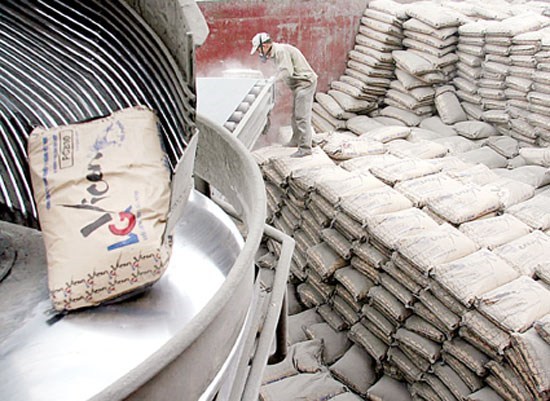Cement producers urged to be flexible
Vietnam’s cement sector is facing oversupply and firms need flexible business strategies to overcome the difficulties.
 Illustrative image (Photo: VNA)
Illustrative image (Photo: VNA) Hanoi (VNS/VNA) – Vietnam’s cement sector is facing oversupply and firms need
flexible business strategies to overcome the difficulties.
The sector was expected to see many challenges this year due to the complex changes of the COVID-19 pandemic, with real estate projects short of capital.
Figures from the Ministry of Construction showed the country would have a cement output of more than 100 million tonnes this year while local consumption was forecast at 67 million tonnes. Meanwhile, cement exports have sharply decreased. In the first five months of the year, the sector earned only 515 million USD from exports, a 13 percent year-on-year decrease.
A report from the FPT Securities Company (FPTS) said the prospects for the housing construction material segment in 2020 would continue to suffer due to tightening management of housing construction permits, along with decreased housing demand. In the short term, new construction activities would be affected, making it harder to sell cement.
In the first five months of 2020, cement consumption reduced by 10 percent year-on-year. Many firms had to lower their business goals.
Vicem Ha Tien 1 Company approved its goals this year at its recent shareholder meeting with net revenue of 8.5 trillion VND, down 2.9 percent from last year. Its pre-tax profit goal dropped by 10.6 percent to 830 billion VND.
Last year, the company reached a net revenue of 8.8 trillion VND, up 5 percent from the previous year and meeting 99 percent of set targets. Its pre-tax profit grew by 14 percent to 928 billion VND while after-tax profit was 741 billion VND.
Vicem Hoang Mai Company also set a cautious business plan this year with sale of 1.6 million tonnes and revenue of 1.6 trillion VND. Its pre-tax and after-tax profit goals were also set lower than last year.
The cement sector has seen the highest inventory in years with a sudden sharp decrease in the first five months of the year. By the end of the first quarter, the sector’s inventory was 4.8 million tonnes.
The company said the cement market this year would continue to be a thermometer for local producers as oversupply was more than 30 million tonnes, causing fierce competition. Therefore, weak firms would have to stop operation, especially in the central region due to increasing supply from Tan Thang Cement Company (Nghe An) with the capacity of 2 million tonnes and Nam Dong Cement Company (Thua Thien Hue). In addition, big cement factories such as Thanh Thang, Xuan Thanh, Long Son, Ha Long and SCG have invested in warehouses and distribution stations to expand the central region market.
Meanwhile, the Philippine Department of Trade and Industry (DTI) has applied safeguard measures from 2019 to 2021 on cement imported from Vietnam, which has greatly affected the industry, because the country is one of the three largest consumer markets. Since the tax was imposed in early 2019, exports to the Philippines have decreased by 23 percent in volume and 17.4 percent in value, reaching only 257 million USD.
FPTS said difficulties both domestically and in exports would make cement inventory in 2020 reach 8 million tonnes, while cement prices in the north, central and south regions would decline by 3.3 percent, 4.1 percent and 1.5 percent respectively over the same period last year.
Although the prospects for the construction and building materials industries in 2020 were not positive, most firms think that this is the time for restructuring towards more transparent and professional development./.
The sector was expected to see many challenges this year due to the complex changes of the COVID-19 pandemic, with real estate projects short of capital.
Figures from the Ministry of Construction showed the country would have a cement output of more than 100 million tonnes this year while local consumption was forecast at 67 million tonnes. Meanwhile, cement exports have sharply decreased. In the first five months of the year, the sector earned only 515 million USD from exports, a 13 percent year-on-year decrease.
A report from the FPT Securities Company (FPTS) said the prospects for the housing construction material segment in 2020 would continue to suffer due to tightening management of housing construction permits, along with decreased housing demand. In the short term, new construction activities would be affected, making it harder to sell cement.
In the first five months of 2020, cement consumption reduced by 10 percent year-on-year. Many firms had to lower their business goals.
Vicem Ha Tien 1 Company approved its goals this year at its recent shareholder meeting with net revenue of 8.5 trillion VND, down 2.9 percent from last year. Its pre-tax profit goal dropped by 10.6 percent to 830 billion VND.
Last year, the company reached a net revenue of 8.8 trillion VND, up 5 percent from the previous year and meeting 99 percent of set targets. Its pre-tax profit grew by 14 percent to 928 billion VND while after-tax profit was 741 billion VND.
Vicem Hoang Mai Company also set a cautious business plan this year with sale of 1.6 million tonnes and revenue of 1.6 trillion VND. Its pre-tax and after-tax profit goals were also set lower than last year.
The cement sector has seen the highest inventory in years with a sudden sharp decrease in the first five months of the year. By the end of the first quarter, the sector’s inventory was 4.8 million tonnes.
The company said the cement market this year would continue to be a thermometer for local producers as oversupply was more than 30 million tonnes, causing fierce competition. Therefore, weak firms would have to stop operation, especially in the central region due to increasing supply from Tan Thang Cement Company (Nghe An) with the capacity of 2 million tonnes and Nam Dong Cement Company (Thua Thien Hue). In addition, big cement factories such as Thanh Thang, Xuan Thanh, Long Son, Ha Long and SCG have invested in warehouses and distribution stations to expand the central region market.
Meanwhile, the Philippine Department of Trade and Industry (DTI) has applied safeguard measures from 2019 to 2021 on cement imported from Vietnam, which has greatly affected the industry, because the country is one of the three largest consumer markets. Since the tax was imposed in early 2019, exports to the Philippines have decreased by 23 percent in volume and 17.4 percent in value, reaching only 257 million USD.
FPTS said difficulties both domestically and in exports would make cement inventory in 2020 reach 8 million tonnes, while cement prices in the north, central and south regions would decline by 3.3 percent, 4.1 percent and 1.5 percent respectively over the same period last year.
Although the prospects for the construction and building materials industries in 2020 were not positive, most firms think that this is the time for restructuring towards more transparent and professional development./.













